engine coolant AUDI A5 CABRIOLET 2013 Owners Manual
[x] Cancel search | Manufacturer: AUDI, Model Year: 2013, Model line: A5 CABRIOLET, Model: AUDI A5 CABRIOLET 2013Pages: 290, PDF Size: 72.35 MB
Page 12 of 290
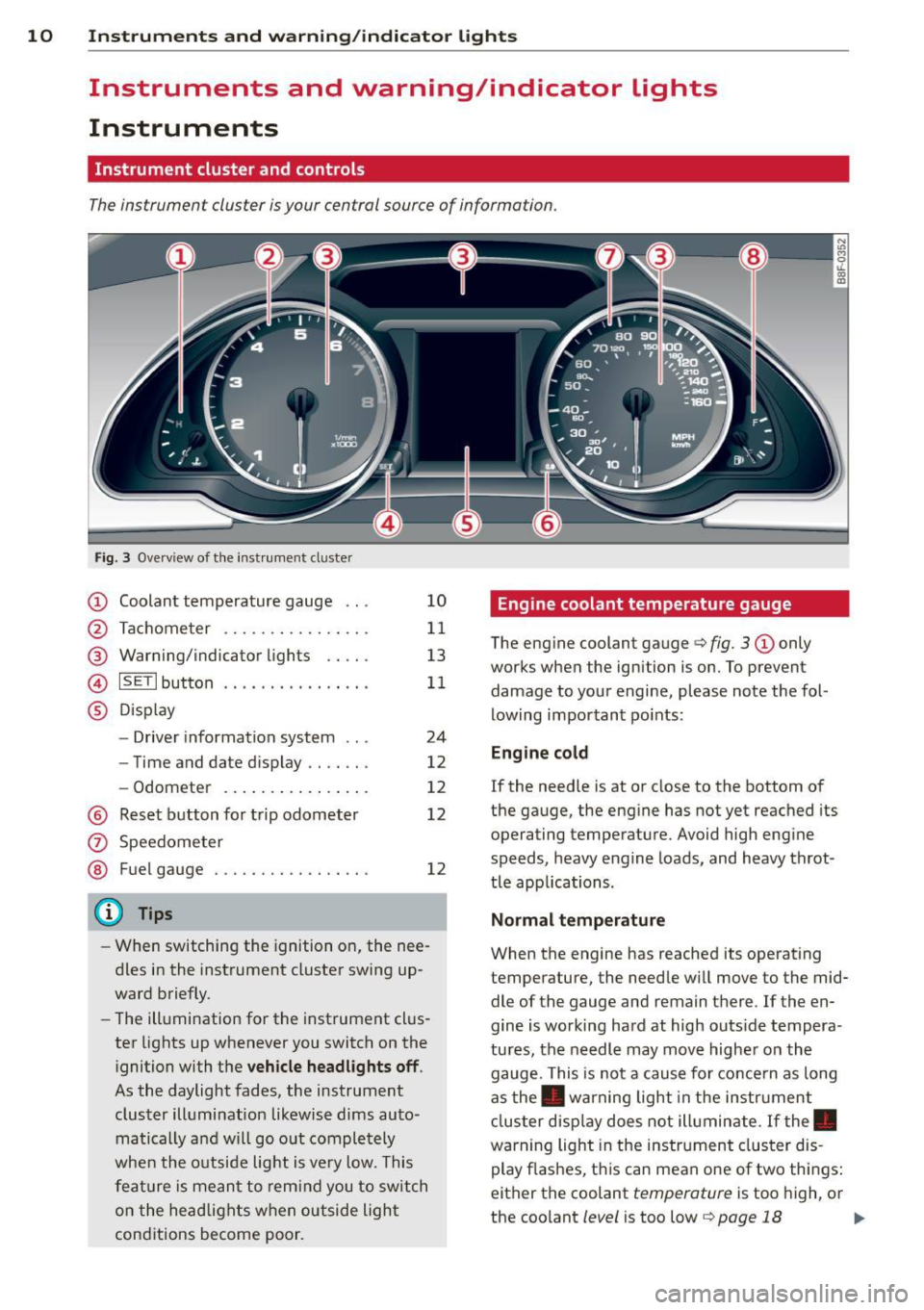
10 Instruments and warning/indicator lights
Instruments and warning/indicator Lights
Instruments
Instrument cluster and controls
The instrument cluster is your central source of information.
Fig. 3 Overv iew of the inst rument cluster
CD Coolant temperature gauge .. .
@ Tachometer ............... .
@ Warning/indicator lights .. .. .
© IS ETlbutton ............ .. . .
® Display
- Driver information system .. .
- Time and date d isplay .. .. .. .
- Odometer ............. .. .
@ Reset button for trip odometer
(z) Speedometer
@ Fuel gauge . ......... .. .. .. .
@ Tips
10
11
13
11
24
12
12
12
12
- When switching the ignition on, the nee
dles in the instrument cluster swing up
ward briefly.
- The illumination for the instrument clus
ter lights up whenever you switch on the
i gnition with the
vehicle headlights off .
As the daylight fades, the instrument
cluster illumination likewise dims auto
matically a nd will go out completely
when the outside light is
very low. This
feature is meant to remind you to switch
on the headlights when outside light
conditions become poor.
Engine coolant temperature gauge
The engine coolant gauge c> fig. 3 CD only
works when the ignition is on. To prevent
damage to your engine, please note the fol
lowing important points:
Engine cold
If the needle is at or close to the bottom of
the gauge, the engine has not yet reached its
operating temperature. Avoid high engine
speeds, heavy engine loads, and heavy throt
tle app lications.
Normal temperature
When the engine has reached its operating
temperature, the needle will
move to the mid
dle of the gauge and remain there . If the en
gine is working hard at high outs ide tempera
tures, the needle may
move higher on the
gauge. This is not a cause for concern as long
as the . warning light in the instrument
cluster display does not illuminate. If the.
warning light in the instrument cluster dis
play flashes, this can mean one of two things:
either the coolant
temperature is too high, or
the coolant
level is too low c> page 18 Ill-
Page 13 of 290
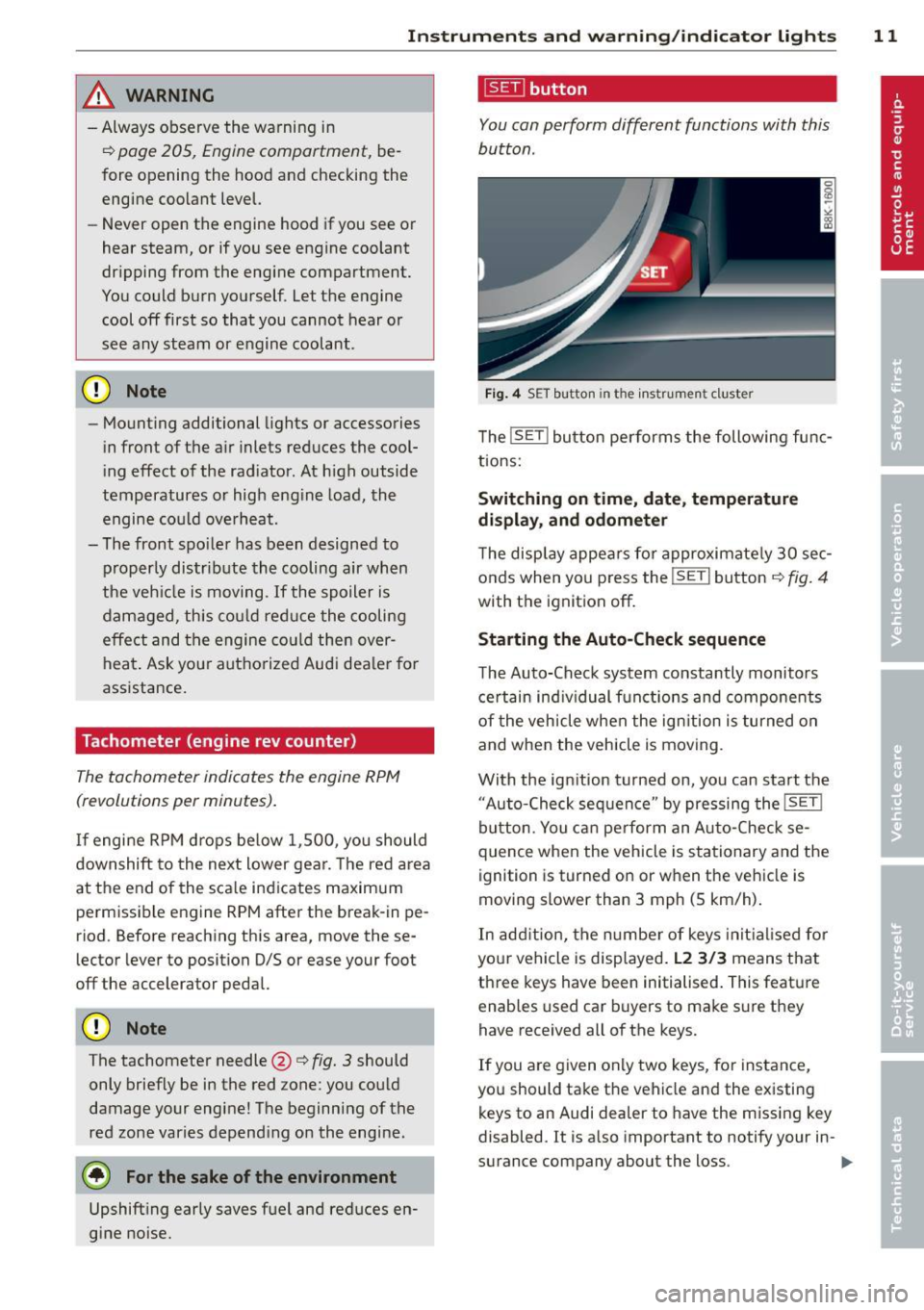
Instrument s and warning /indicator lights 11
/! WARNING
- Always observe the warning in
¢ page 205, Engine compartment, be
fore opening the hood and checking the
engine coolant level.
- Never open the engine hood if you see or
hear steam, or if you see engine coolant
dripping from the engine compartment.
You could burn yourself . Let the engine
cool off first so that you cannot hear or
see any steam or engine coolant .
(D Note
-Mounting additional lights or accessories
in front of the air inlets reduces the cool
i ng effect of the radiator . At h igh outside
temperatures or high engine load, the
engine could overheat.
- The front spo iler has been designed to
properly distribute the cooling air when
the veh icle is moving. If the spoiler is
damaged, this could reduce the cooling
effect and the engine could then over
heat. Ask your authorized Audi dealer for
assistance.
Tachometer (engine rev counter)
The tachometer indicates the engin e RPM
(revolutions per minutes).
If engine RPM d rops be low 1,500 , you should
downshift to the next lower gear. The red area
at the end of the scale indicates maximum
permissible engine RPM after the break-in pe
riod . Before reaching this area, move these
lector lever to position D/S or ease your foot
off the accelerator pedal.
(D Note
The tachometer needle@¢ fig. 3 should
only briefly be in the red zone: you cou ld
damage your engine! The beginning of the
red zone varies depending on the engine.
@) For the sake of the environment
Upshifting early saves fuel and reduces en
gine noise.
~ button
You can perform different functions with this
button .
Fig. 4 SET but ton in th e in str ume nt cluster
The !SE T! button performs the following func
tions:
Switching on time, date , temperature
display, and odometer
The display appears for approximately 30 sec
onds when you press the
!SE Ti button ¢ fig. 4
with the ignition off.
Starting the Auto -Check sequence
The Auto-Check system constantly monitors
certain ind iv idual functions and components
of the vehicle when the ign ition is turned on
and when the vehicle is moving .
With the ignition turned on, you can start the " Auto-Check sequence" by pressing the
!S ET i
button. You can perform an Auto-Check se
quence when the vehicle is stationary and the
ignition is turned on or when the vehicle is
moving slower than 3 mph (5 km/h) .
In addition, the number of keys initial ised fo r
your vehicle is displayed.
L2 3/3 means that
three keys have been initialised. This feature
enables used car buyers to make sure they
have received all of the keys.
If you are given only two keys, for instance,
you should take the vehicle and the existing keys to an Audi dealer to have the missing key
disabled.
It is also important to notify your in -
surance company about the loss .
IJJ,-
Page 20 of 290
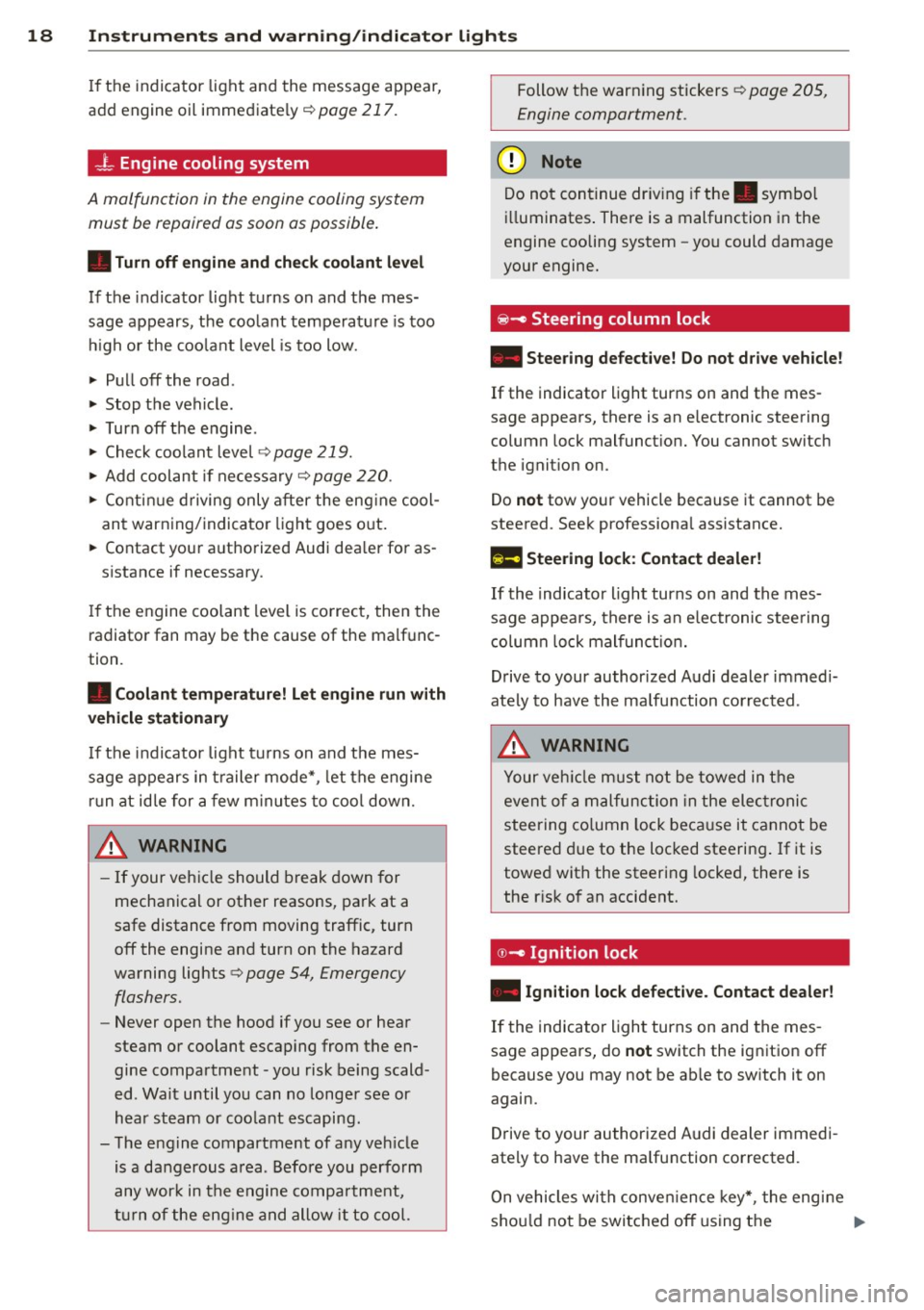
18 Instrum ent s and w arn ing /indic ato r light s
If the indicator light and the message appear,
add engine oil immediate ly
r=) poge 217.
_l Engine cooling system
A malfunction in the engine cooling system
must be repaired as soon as possible .
• Turn off engin e and che ck cool ant l evel
If the indicator light turns on and the mes
sage appears, the coolant temperature is too
h igh or the coo lant level is too low.
.. Pull off the road .
.. Stop the vehicle .
.. Turn off the engine.
.. Check coolant level
r=)page 219.
.. Add coolant if necessary r=) page 220 .
.,. Contin ue driving only after the eng ine cool
ant warning/indicator light goes o ut .
.. Contact your authorized Audi dea ler for as-
sistance if necessary .
I f the engine coolant level is co rrect, then the
radiator fan may be the cause of the malfunc
tion.
• Coo lan t te mper ature! L et engine run wi th
ve hicle s ta ti ona ry
If the indicator light turns on and the mes
sage appears in t railer mode*, let the engine
r u n at id le for a few m inutes to cool down.
& WARNING
- If your vehicle should break down for
mechanical or other reasons, park at a
safe distance from moving traffic, turn
off the engine and turn on the hazard
warning lights¢
page 54, Emergency
flashers.
-
- Never open the hood if you see or hear
steam or coolant escap ing from the en
gine compartme nt -you risk being scald
ed . Wait until you can no longer see or
hear steam or coo lant escaping.
- The engine compartment of any veh icle
is a dangerous area. Before you perform
any wor k in the engine compartment,
t ur n of the eng ine and allow it to cool. Follow the warning stickers
r=)
page 205,
Engine comportment.
@ Note
Do not continue driving if the. symbo l
i ll uminates . There is a malfunction in the
engine cooling system -you could damage
your engine.
@ -Steer ing column lock
• Steering defect ive! Do not drive v ehicle!
If the indicator light turns on and the mes
sage appears, there is an e lectronic steering
column lock malfunct ion. You cannot switch
the ignit ion on .
Do
not tow yo ur vehicle because it cannot be
steered. Seek professiona l assistance.
ell Steering lo ck : C ont act de aler !
If the indicator light turns on and the mes
sage appears, there is an e lectronic stee ring
column lock malfunct ion.
D rive to your authorized Audi dealer immedi
ately to have the ma lfunction corrected .
& WARNING
-
Your vehicle must not be towed in t he
event of a malfunction in the elec tronic
steering co lumn lock beca use it cannot be
steered due to the locked steering . If it is
towed with the steering locked, there is
the r isk of an accident.
© -Ignition lock
• Ignition lo ck defecti ve . Cont act de aler !
If the indicator light turns on and the mes
sage appears, do
not switch the ignition off
because you may not be ab le to switch it on
again.
Drive to your authorized A udi dealer immedi
ately to have the malfunction corrected.
On vehicles with conve nience key*, the engine
shou ld not be switched off using the ..,.
Page 72 of 290

70 Warm and cold
Warm and cold Climate controls
Description
The climate control system warms, cools and
adds humidity to the air in the vehicle interior.
It is the most effect ive when the windows and
sunroof are closed . If there is a build-up of
heat inside the vehicle, ventilation can help to
speed up the cooling process.
I n all heating mode functions except
defrost,
the blower on ly switches to a higher speed
once the engine coolant has reached a certain
temperature.
Condensat ion from the cooling system can
drip and form a puddle of water under the ve
hicle. This is normal and does not mean there
is a leak.
Pollutant filter
The pollutant filter removes pollutants s uch
as dust and pollen from the air.
The air pollutants filter must be changed at
the intervals spec ified in you r Warranty
&
Maintenance booklet, so that the air condi
tioner can properly work.
If you drive your vehicle in an area with h igh
a ir po llution, the fi lter may need to be
changed more frequently than specified in
your Aud i Wa rranty
& Ma intenance booklet. If
in doubt, ask your authorized Audi Service Ad
visor for advice .
Key coded settings
The climate control settings are automat ically
stored and assigned to the remote control key
that is in use. These settings are different
when the power top is open or closed .
A WARNING
Reduced visibility is dangerous and can
cause accidents. -
- For safe driving it is very important that
all windows be free of ice, snow and con
densation.
- Comp letely familiarize yourself with the
proper use and function of the heating
and ventilation system and especially how to defog and defrost the windows.
- Never use the windshield wiper/washer
system in freez ing weather unt il you
have warmed the windshield first, using
the heating and ventilation system. The
washer solution may freeze on the wind shie ld and reduce visib ility.
(D Note
- If you suspect that the air conditioner has been damaged, switch the system
off to avoid further damage and have it
inspected by a qualified dealership.
- Repairs to the Audi air conditioner re
quire special technical know ledge and
special tools. Contact an authorized Aud i
dea ler fo r assistance.
@ For the sake of the environment
By reducing the amount of fuel you use,
you also reduce the amount of pollutants
emitted into the air.
(D Tips
- Keep the air intake s lots (in fro nt of the
w indshield) free from ice, snow and de
bris in order to maintain the proper func
tion of the climate control system.
- The energy management system may
switch the seat heating* or rear window
defroster off temporarily . These systems
are available again as soon as the energy
balance has been restored.
- Air escapes through vents under the rear
window. When placing items of clothing
on the luggage compartment cover, en
sure that the openings are not covered.
Page 81 of 290

note that electrica l equipment such as
exterior lights wi ll switch off as well
when that happens.
Switching engine off
App lies to vehicles: with conve nien ce key
.,. Bring your vehicle to a complete stop.
.,. Move the selector lever to the P or N posi
t ion.
... Press the
!START E NGIN E STOPI button
~fig. 91.
St eering lock
The steering locks when you turn the engine
off us ing the
I STAR T ENGINE STOP I button
and open the dr iver's door . The locked steer
ing he lps prevent vehicle theft.
E mergenc y off
If necessary, the eng ine can be sw itched off
with the selector lever in the R or D/S pos i
tions. To do so, step on the brake peda l and
press and hold the
I STAR T ENGINE STOP I but
ton vehicle speed must be less than 6 mph
(10 km/h).
.&, WARNING
-Never t urn off the eng ine be fore the ve
hicle has come to a complete stop . The
f ull function of the brake booster and the
power steering is not guaranteed . You
must use more force to turn or brake if
necessary. Because you cannot steer and
brake as you usua lly would, this could
lead to c rashes and serious injur ies.
- For safety reasons, you should always
park your vehicle with the se lector lever
in P . Otherwise, the veh icle could i nad
vertent ly roll away .
- The rad iator fan can continue to run for
up to 10 minutes eve n after you have
tu rned off the eng ine and removed the
ignition key. The radiator fan can also
turn on again i f the engine coolant hea ts
up because of intense sunlight or hea t
build -up in the engine compartment.
On th e ro ad 79
-Always take the key w ith you whenever
you leave your ve hicle. Otherw ise, the
e ngine could be started or electrical
equipment such as the power windows
could be operated. This can lead to seri
ous injury.
(D Note
If the engine has been under heavy load
for an extended period, heat bu ilds up in
the eng ine compartment after the eng ine
i s sw itched off - there is a r is k of damag ing
the e ngine. A llow the eng ine to run at id le
for abo ut two minutes before switching it
off.
Driver messages
I g nition i s on
This message appears and a warning tone
sounds if you open the d river's door when the
ignition is sw itched on .
No key ident ified
This message appears when the
I S TART ENGINE STOP I button is pressed if
there is no master key ins ide the ve hicle or if
the system does not recognize it . For exam
ple, the master key cannot be recognized if it
i s covered by an object (e .g . aluminum brief
case) which
screens the radio s ignal. Electron
ic dev ices such as cell p ho nes can also inte r
f ere with the radio s ignal.
Pr ess brake p edal to start engine
This message appears if you do not press the
brake pedal to start the eng ine .
Shift to N or P to start engine
T h is message appears w hen a ttempt ing to
star t the eng ine if the selecto r lever for the
automatic transmiss ion is not in the P or N
pos ition . The engine can only be started with
the se lector in these positions.
Is the ke y in the vehicle ?
Page 194 of 290

192 Trailer towing
Tire pre ss ure
When towing a trai le r, inflate the t ires of your
vehicle to the co ld tire pressure listed under
"Full load" on the label located on the driver 's
side B-pillar (visible when the door is open).
Inflate trailer tires to trailer and tire manufac
turers' specifications.
Light s
The headlight settings should be checked with
the trailer attached before dr iving off. Check
to make sure both vehicle and tra iler lights
are working properly.
Saf ety chains
Be sure tra iler sa fe ty cha ins a re p roperly con
nected from the trailer to the hitch on the ve
hicle. Leave eno ugh slack in the chains to per
mit turning corners. When you install safety
cha ins, make sure they w ill not drag on the
road when you are driving.
The chains shou ld cross under the trai ler
tongue to prevent it from dropping in case of
separation from the hitch.
Driving instructions
Driving with a trailer always requires extra
care and consideration.
To obtain the best possible handling o f vehicle
and trai ler, p lease note the following:
.,. Do not tow a loaded tra iler whe n your car it
self is no t loaded .
.,. Be especia lly careful when passing other
vehicles .
.,. Observe speed limits .
.,. Do not drive at the maximum permissible
speed.
.,. Always apply brakes early .
.,. Monitor the temperature gauge.
Weigh t di stribution
Towing a loaded trai ler with an empty car re
sults in a highly unstable distribution of
weight . If this cannot be avo ided, drive at very
low speeds only to avoid the risk of losing
steer ing control. A "ba
lanced' ' rig is easier to operate and con
trol. This means that the tow vehicle should be loaded to the extent possible and permissi
ble, while keep ing the trai ler as light as possi
ble under the c ircumstances. Whenever poss i
ble, transfer some cargo to the luggage com
partment of the tow veh icle while obse rving
tongue load requ irements and vehicle load ing
considerations.
Speed
The higher the speed, the more d iff icu lt it be
comes for the driver to control the rig. Do not
drive at t he maximum permissible speed. Re
duce your speed even more if load, weather or
wind conditions are unfavorable -pa rtic ularly
whe n going downhill.
Reduce veh icle speed
immediately if the trail
er shows the slightest s ign of sway ing.
Do n ot
try to sto p th e swaying by acc elerating .
Observe speed limits. In some areas, speeds
fo r vehicles tow ing tra ile rs a re lower than for
regular veh icles .
Always apply brakes early. When driving downh ill, shift into a lower gear to use the en
gine braking effect to slow the vehicle . U se of
the brakes alone can cause them to overheat
and fail.
Coolant tempe rature
The coo lant temperature gauge c> page 10
must be observed carefu lly. If the needle
moves close to the upper end of the scale, re
duce speed immediately and/or turn off the
air conditioner.
If the coolant temperature warning light •
i n t he i nstrument cluster starts flashing, pull
off the road, stop and let the engine
idle for
abo ut two min utes to prevent he at build-up .
_& WARNING
Anyone not proper ly restra ined in a mov
i ng vehicle is a t a much greater risk in an
accident . Never let anyone ride in yo ur car
who is not p roperly wea ring the rest raints
prov ided by Audi.
-
Page 215 of 290
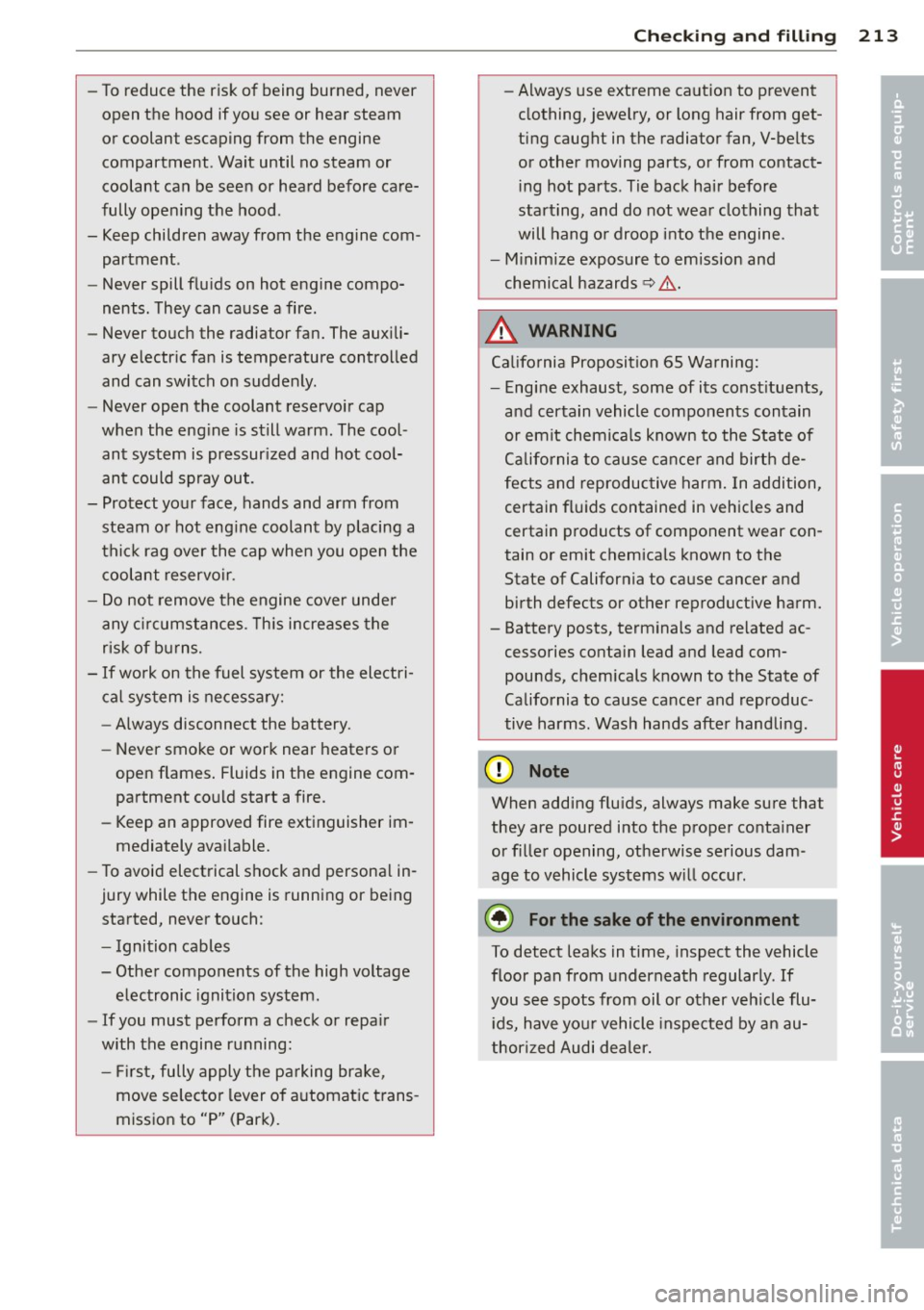
-To reduce the r isk of being burned, never
open the hood if you see or hear steam
or coolant escaping from the engine
compartment . Wait until no steam or
coolant can be seen or heard before ca re
fully opening the hood .
- Keep children away from the engine com
partment.
- Never spill flu ids on hot engine compo
nents. They can cause a fire .
- Never touch the radiator fan. The aux ili
ary e lectr ic fan is temperature controlled
and can switch on suddenly .
- Never open the coolant reservoir cap
when the eng ine is still warm . The cool
ant system is pressur ized and hot coo l
ant could spray out.
- Protect your face, hands and arm from
steam or hot eng ine coolant by placing a
thic k rag over the cap when you open the
coolant reservoir.
- Do not remove the engine cover under
any c ircumstances. Th is increases the
risk of bu rns.
- If wo rk on the fuel system or the electri
cal sys tem is ne cessary:
- Always disconnect the battery.
- Never smoke or work near heaters or
open flames . Fluids in the engine com
partment co uld start a fire.
- Keep an approved fire extinguisher im
mediately ava ilable.
- To avoid electrical s hock and persona l in
jury while the engine is running or being
started, never touch:
- Ignition cables
- Other components of the high voltage
electronic ignition system.
- If you must perform a check or repa ir
with the engine running:
- Fir st, fully apply the parking brake,
move se lector lever of a utomatic trans
mission to "P" (Park).
Checkin g and fillin g 213
-Always use extreme caution to prevent
clothing, jewelry, or long hair from get
ting caught in the radiator fan, V-be lts
or other moving parts, or from contact
i ng hot parts . Tie back hair before
starting, and do not wear clothing that
will hang o r droop into the engine.
- Minimize exposure to em ission and
chemical hazards
9 .&, .
&_ WARNING
Califo rnia Proposition 65 Wa rni ng:
- Engi ne exhaust, some of its const ituents,
and certa in vehicle components contain
or emit chemi cals known to the State of
California to cause cancer and birth de
fects and reproduc tive harm. In addition,
certain fl uids con tained in vehicles and
certain products of component wear con
tain or emit chemica ls known to the
State of California to cause cancer and
birth defects or other reproductive harm.
- Battery posts, terminals and related ac
cessories conta in lead and lead com
pounds, c hemicals known to the State of
California to cause cancer and reproduc
tive harms. Wash hands afte r handling .
(D Note
When adding flu ids, always make sure that
they are poured into the proper conta iner
or f iller opening, otherwise serious dam
age to vehicle systems w ill occur .
@ For the sake of the environment
To detect leaks in time, inspect the vehicle
floor pan from underneath regularly . If
you see spots from oil or other veh icle flu
i ds, have you r vehicle inspected by an au
thori zed Audi dealer. •
•
Page 216 of 290

214 Checking and filling
Engine compartment
Engine compartment
These are the most important items that you can check.
Fig. 175 Typical layout for containers and eng ine o il filler cap
(D Eng ine o il filler cap ("1::::r.) . . . . . 21 7
@ Jump start point(+) under a cov-
er .. .. .... ... ....... .... ..
225, 260
@ Bra ke fluid reservo ir (0)) . . . . . 221
@ Coolant expansion tank (-L) . . . 220
® Jump start point(-) with hex
head sc rew ..... .......... ..
225, 260
® W indshield/headlight* washer
. (" ') container o ....... . ... .. . 226
The pos ition o f the engine o il fi lling hole
¢ fig . 175 (item @) can differ depending on
the eng ine design.
A WARNING
Before yo u check anything in the engine
compartment, always read and heed all
WARNINGS ¢.&. in Working in the engine
compartment on page 212.
-
Engine oil
· Engine oil specifications
The engine oil used in your Audi needs the
right kind of oil.
The eng ine in your Audi is a sophist icated
power plant that was b uilt to exacting specifi
cations . Th is engine needs the right k ind of
engi ne oil that meets specifica tions regard ing
quality a nd v iscosity so that it can run
smooth ly and reliab ly. Choosing the rig ht o il
and changing oil within the t ime and mile age
i n tervals prin ted in you r vehicle's Warr anty
&
Maintenance booklet matters a lot more to
day tha n it did years ago . Aud i has deve loped
a spec ia l quality standard for engine oil that
will help assure that your vehicle 's engine w ill
get the lubr ication it needs for proper opera-
t ion . ..,_
Page 221 of 290
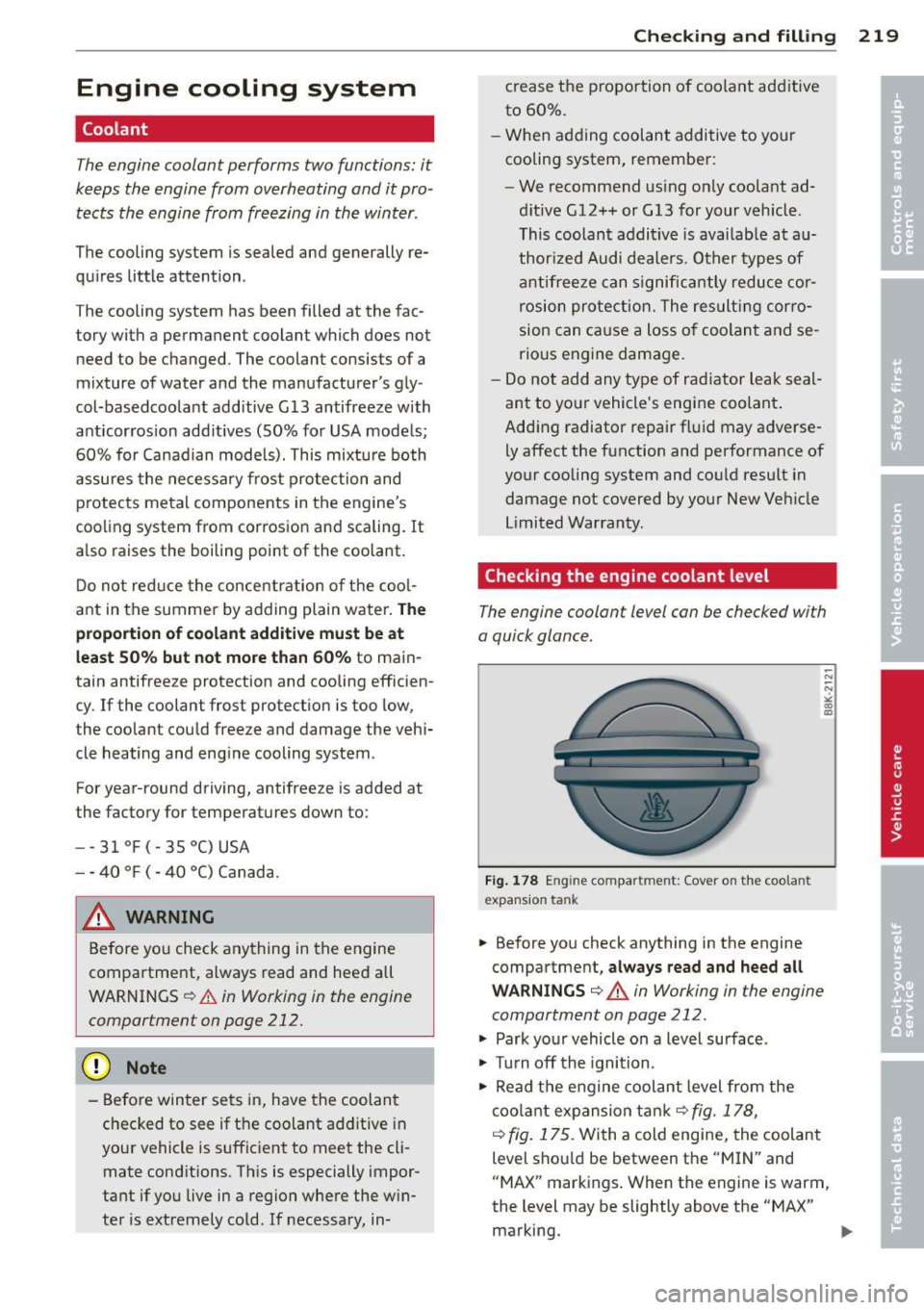
Engine cooling system
Coolant
The engine coolant performs two functions: it
keeps the engine from overheating and it pro
te cts the engine from freezing in the winter .
The cooling system is sealed and generally re
qu ires little attention .
The cooling system has been filled at the fac
tory with a permanent coolant which does not need to be changed. The coolant consists of a
mixture of water and the manufacturer's gly
col-based coolant additive G 13 antifreeze with
anticor ros ion add itives (50% for USA mode ls;
60% for Canadian mode ls). This mixtu re both
assures the ne cessa ry frost prote cti on and
p rotec ts metal components in the engine's
coo ling system from cor ros io n an d scaling. It
a lso raises the boiling point of the coolant.
D o not red uce the con cent ration o f th e coo l
ant in the summe r by adding plain water .
The
proportion of coolant additive must be at least 50% but not more than 60%
to ma in
tain antifreeze protection and cooling efficien
cy. If the coolant frost protect ion is too low,
the coolant cou ld freeze and damage the veh i
cle heating and eng ine cooling system .
For yea r-round driving, antifreeze is added at
the factory for temperatures down to:
- -3 1 °F (-35°C)USA
- -4 0 ° F ( - 40 °C) Canada.
A WARNING
Before yo u check any thing in the engine
compartment, always read and hee d all
W AR NIN GS
¢ .&. in Working in the engine
compartment on page 212.
(D Note
- Before win ter se ts in, have the coolan t
checked to see if t he coolant ad dit ive i n
your vehicle is suffic ient to meet the cli
mate cond itions . T hi s is especially imp or
tant if you live in a regi on whe re the w in
te r is e xtremely cold. If necessary, in -
Checking and fillin g 219
crease the propo rtion of coo lant add itive
to 60%.
- When adding coolant additive to yo ur
coolin g system , remembe r:
- We reco mmend us ing o nly coola nt ad
d itive G12++ or G13 for your vehicle .
This coolan t ad ditive is availab le at a u
thor ized Audi dealers. O ther types of
ant ifree ze can s ignific antly red uce cor
rosion pro tec tion . The result ing corro
sion can ca use a loss o f coolan t and se
rio us en gine damage.
- D o not add any ty pe of rad iator leak seal
ant to yo ur vehicle 's engine coolan t.
Adding radiator repair fl uid may adverse
ly affect the function and performance of
your cooling system and co uld resu lt in
damage not covered by you r New Ve hicle
Limited War ran ty.
Checking the engine coolant level
The engine coolant level can be checked with
a quick glance.
Fig . 1 78 Eng in e co mpa rtm ent : Cover o n the coo la nt
expans io n t an k
-... ;;; ,; a, m
.. Before yo u check anything in the engine
compartment,
always read and heed all
WARNINGS ¢ & in Working in the engine
compartment on page 212 .
"' Park yo ur vehicle on a lev el su rface .
"' Turn off the ignition .
"' Read t he e ngine coolant level from the
coo lant expan sio n ta nk ¢
fig. 178 ,
¢ fig. 175. With a cold engine, the coolant
level sho uld be between the "MIN " and
"MAX" markings . When the engine is warm,
the level may be slightly above the "MAX"
marking.
Iii>
Page 222 of 290
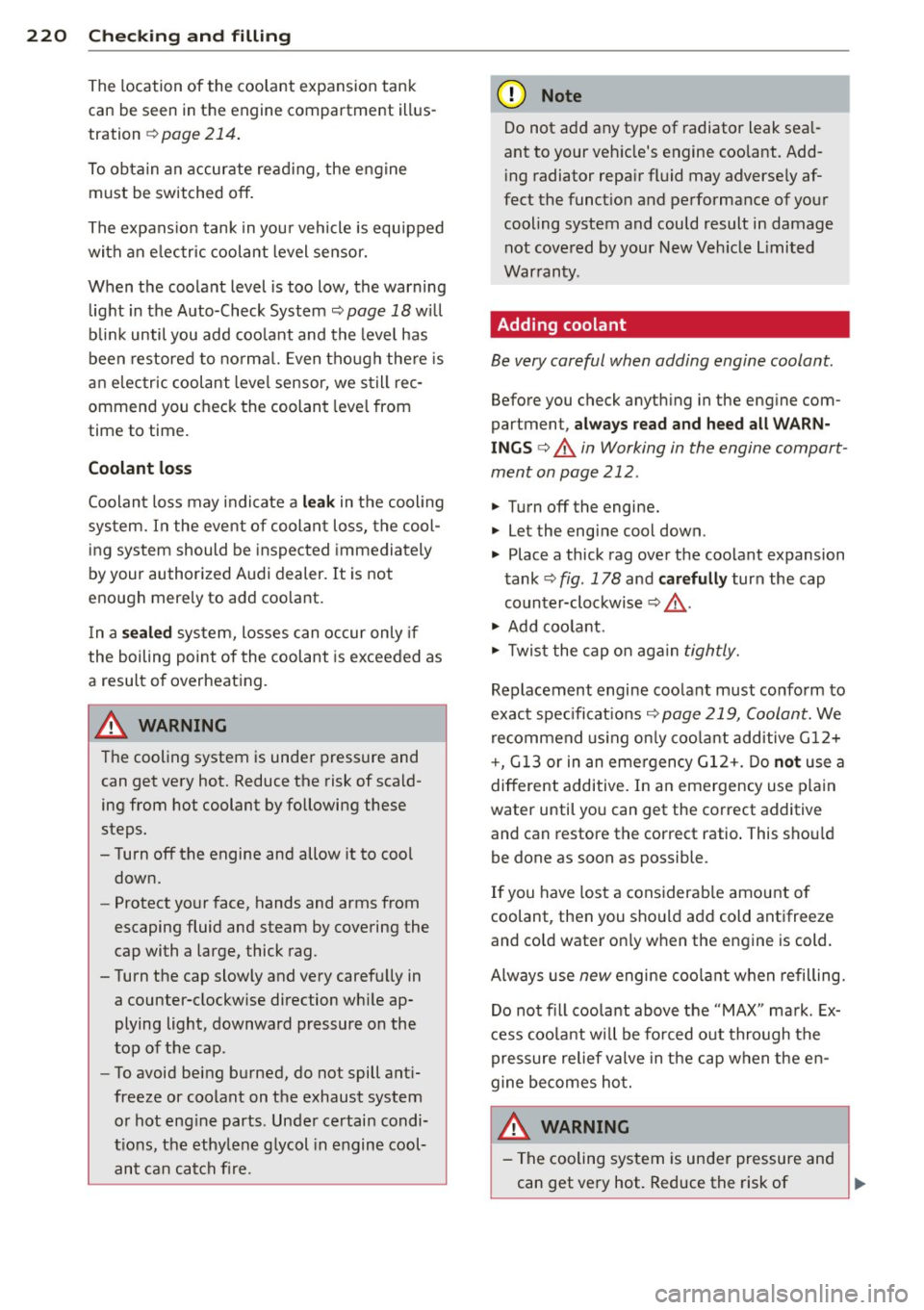
220 Check ing and filling
The location of the coolant expansion tank
can be seen in the engine compartment illus
tration ¢
page 214 .
To obtain an accurate read ing, the eng ine
must be switched off .
The expans io n tank in you r vehicle is equipped
with an e lectr ic cool ant level sensor.
When the coolant level is too low, the warning light in the A uto-Check System ¢
page 18 will
b link until you add coo lant and the level has
been restored to no rm al. Even though the re is
an e lec tric coolant level sensor, we s till rec
ommend you check the coolant leve l from
time to time.
Coolant loss
Coolant loss may indicate a leak in the cooling
system. In the event of coolan t loss, the cool
i ng system should be inspected immedia tely
by your authorized A udi dealer. It is not
enough merely to add coolant.
I n a
s e aled system, losses can occur only if
the boiling poin t of the coolant is excee ded as
a result of overheating.
A WARNING
The cooling system is unde r pressure and
can get ve ry hot. Reduce the risk of sca ld
ing from hot coolant by following these
steps.
- Turn off the engine and allow it to cool
down.
- Protect yo ur face, hands and arms from
escaping fluid and steam by covering the
cap with a large, thick rag.
- Turn the cap slowly and ve ry carefu lly in
a counter-clockwise direction wh ile ap
plying light, downward pressure on the
top of the cap .
- To avoid being b urned, do not spill ant i
freeze or coolant on t he exhaust system
or hot eng ine parts. Unde r certain condi
tions, t he ethy lene g lycol in engine cool
an t can ca tch fire.
(D Note
Do not ad d any type of radiator leak sea l
ant to your veh icle's engine coo lant. Add
i ng radiator repa ir fluid may adverse ly af
fect the funct ion and performance of your
cooling system and could result in damage not cove red by your New Veh icle L imited
War ran ty .
Adding coolant
Be very careful when adding engine coolant.
Before you check anyth ing in the eng ine com
partment,
always read and heed all WARN
INGS c> &. in Working in the engine compart
ment on page 212.
.. Turn off the engine.
.. Let the engine cool down.
.. Place a thick rag over the coolant expansion
tank ¢
fig. 178 and carefully turn the cap
co unter-clo ckwise ¢,&. .
.,. Add coo lant.
.. Twis t the cap on aga in
t ightly.
Replacement engine coo lant must confo rm to
exact spec ificat ions
¢ page 219, Coolant. We
re commend using on ly coo la nt additive G 12+
+ , G 13 or in an eme rgen cy G12+. Do
not use a
different additive. In an emergency use plain
water until yo u can get the correct additive
and can restore the correct ratio . This shou ld
be done as soon as possible .
If you have los t a cons iderab le amount o f
coolant , then you sho uld ad d cold antifreeze
and cold wate r on ly w hen the engine is cold.
Always use
new engine coo lant when refilling.
Do not f ill coo lant abov e the "MAX" mark . Ex
cess coo la nt w ill be fo rced o ut thro ugh the
pressure relief valve in t he cap w hen the en
gine becomes hot.
A WARNING
-= -
-The cooling system is under pressure and
can get very hot. Reduce the risk of ..,.